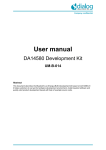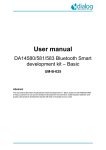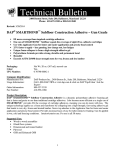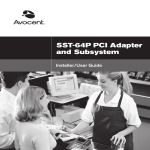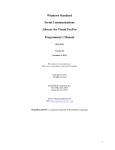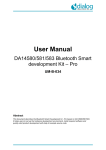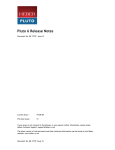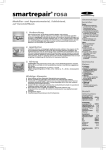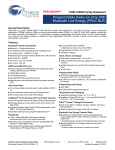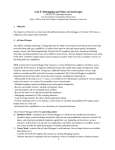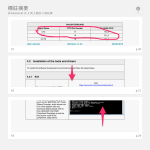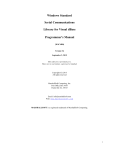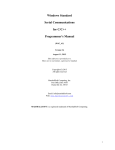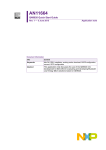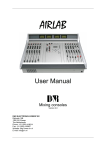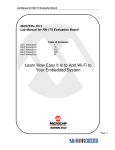Download DA14580 Bluetooth® Smart Development Kit – Basic
Transcript
Company confidential User Manual DA14580 Bluetooth® Smart Development Kit – Basic UM-B-025 Abstract This document describes the Bluetooth Smart Development Kit - Basic based on DA14580-01. It helps users to set up the hardware development environment, install required software and quickly start product development with help of example source code. UM-B-025 DA14580 Bluetooth® Smart Development Kit – Basic Company confidential Contents Contents ............................................................................................................................................... 2 Tables ................................................................................................................................................... 3 Figures .................................................................................................................................................. 3 1 Terms and definitions ................................................................................................................... 4 2 References ..................................................................................................................................... 4 3 Introduction.................................................................................................................................... 5 3.1 Hardware content .................................................................................................................. 5 3.2 Web content .......................................................................................................................... 6 Software Development Kit content ......................................................................... 6 3.2.1 3.3 DA14580DEVK –Basic Kit .................................................................................................... 8 3.3.1 PCB design and functionalities ............................................................................... 8 3.3.2 Electrical Schematics.............................................................................................. 9 3.3.3 Configuring the basic kit-board by jumpersettings ............................................... 11 3.3.4 Schematics and layout .......................................................................................... 12 4 Installation of tools and drivers ................................................................................................. 13 4.1 Keil ...................................................................................................................................... 13 4.2 SEGGER Jlink driver ........................................................................................................... 14 4.3 Tera Term ........................................................................................................................... 14 5 Memory and tools ........................................................................................................................ 15 6 Using the demo kit ...................................................................................................................... 16 6.1 Run an example on DA14580 ............................................................................................. 16 6.2 Run ‘Blinky’ and using the UART. ....................................................................................... 20 7 Power Management: measuring current ................................................................................... 22 Appendix A Layout ............................................................................................................................ 23 Appendix B Connections of J10 and J11 ........................................................................................ 23 Appendix C Using the SmartSnippets CLI ...................................................................................... 24 8 Web-Links .................................................................................................................................... 25 9 Revision history .......................................................................................................................... 25 User manual CFR0012-00 Rev 1 Revision 1.0 2 of 26 10-Jun-2014 © 2014 Dialog Semiconductor GmbH UM-B-025 DA14580 Bluetooth® Smart Development Kit – Basic Company confidential Tables Table 1: Content of the DA14580DEVKT –Basic Kit ............................................................................. 5 Table 2: SDK Examples ........................................................................................................................ 7 Table 3: Installation tools and drivers .................................................................................................. 13 Table 4: Run an example on DA14580 ............................................................................................... 16 Table 5: Way of Working (WoW) loading ‘Blinky’-code ....................................................................... 20 Figures Figure 1: DA14580DEVKT –Basic Kit ................................................................................................... 5 Figure 2: DA14580 Development Kit -Basic .......................................................................................... 8 Figure 3: Topview of PCB with components and functionalities ........................................................... 8 Figure 4: Electrical schematic of DA14580DEVKT-B sheet 1 of 2 ........................................................ 9 Figure 5: Electrical schematic of DA14580DEVKT-B sheet 2 of 2 ...................................................... 10 Figure 6: (Fabrication default) UART boot settings (T_TxD = P0_5 and T_RxD = P0_4) .................. 11 Figure 7: Boot from external SPI memory ........................................................................................... 11 Figure 8: Layout of headers J4 and J6 ................................................................................................ 12 Figure 9: Block diagram with different memory locations .................................................................... 15 Figure 10: Setup of DA14580DEVKT –BASIC during power measurement ....................................... 22 Figure 11: Open the CLI of SmartSnippets ......................................................................................... 24 User manual CFR0012-00 Rev 1 Revision 1.0 3 of 26 10-Jun-2014 © 2014 Dialog Semiconductor GmbH UM-B-025 DA14580 Bluetooth® Smart Development Kit – Basic 1 Terms and definitions BLE CS DK EEPROM FTDI GPIO OTP PCB QFN SDK SPI SRAM SWD USB UART WLCSP WoW 2 1. 2. 3. 4. 5. 6. 7. 8. 9. 10. 11. Company confidential Bluetooth Low Energy Chip Select Development Kit Electrically Erasable Programmable Memory Brand name of USB – UART interface General Purpose Input Output One Time Programmable printed circuit board Quad-Flat No-leads Software Development Kit Serial Peripheral Interface Static Random Access Memory Serial Wire Debug Universal Serial Bus Universal Asynchronous Receiver/Transceiver Wafer Level Chip Scale Packaging Way of Working References DA14580, Datasheet, Dialog Semiconductor UM-B-015, DA14580 Software Architecture, Dialog Semiconductor DA14580 CB PXI QFN40 layout, Dialog Semiconductor DA14580_CB_PXI_QFNP40, Dialog Semiconductor DA14580_CB_PXI_WLCSP, Dialog Semiconductor DA14580_CB_PXI_WLCSP_layout, Dialog Semiconductor DA14580_MB_VB_layout, Dialog Semiconductor DA14580 CB PXI_QFN48, Dialog Semiconductor UM-B-005, DA14580 Peripheral Examples, Dialog Semiconductor UM-B-010, DA14580 Proximity application, Dialog Semiconductor AN-B-015 DA14580 Supply current measurement, Dialog Semiconductor User manual CFR0012-00 Rev 1 Revision 1.0 4 of 26 10-Jun-2014 © 2014 Dialog Semiconductor GmbH UM-B-025 DA14580 Bluetooth® Smart Development Kit – Basic 3 Company confidential Introduction DA14580 is a Bluetooth Smart chip, working with extremely low power while providing world-class RF performance, a small footprint and flexible peripheral configurations for a wide range of applications. DA14580 development kit includes a set of hardware (e.g. development board with on-board debugger), a Software Development Kit (SDK) (e.g. development tools, source code examples documents and so on) along with documentation. This document, as a user guide, helps users to set up hardware/software development environment, install required software and quickly start product development with the help of example source code. Web content can be downloaded at www.dialog-semiconductor.com/support. Product information about DA14580 can be found at: www.dialog-semiconductor.com/products/bluetooth-smart/smartbond-da14580. 3.1 Hardware content In Figure 1 the kit components are shown and in Table 1 the parts are printed. Figure 1: DA14580DEVKT –Basic Kit Table 1: Content of the DA14580DEVKT –Basic Kit DA14580DEVKT –BASIC Battery CR2032 Mini USB Cable User manual CFR0012-00 Rev 1 Revision 1.0 5 of 26 10-Jun-2014 © 2014 Dialog Semiconductor GmbH UM-B-025 DA14580 Bluetooth® Smart Development Kit – Basic Company confidential 3.2 Web content 3.2.1 Software Development Kit content 3.2.1.1 Tools Web-link: www.dialog-semiconductor.com/support SmartSnippets (a framework of PC based tools to control DA14580 development kit), consisting of ● OTP Programmer: Tool for OTP memory programming ● UART booter: Tool for downloading hex files to DA14580 SRAM over UART ● SPI & I2C memory programmer: Tool for SPI flash and I2C EEPROM programming Connection Manager (a PC based software tool to control the link layer of the DA14580), with the following capabilities: ● ● ● ● ● Functional in Peripheral and Central role Set advertising parameters Set connection parameters Reading from Attribute database Perform production test commands 3.2.1.2 ● ● ● ● ● ● ● ● ● ● ● ● SDK documents UM-B-003, DA14580 Software development guide UM-B-004, DA14580 Peripheral drivers UM-B-005, DA14580 Peripheral examples UM-B-006, DA14580 Sleep mode configuration UM-B-007, DA14580 Software Patching over the Air (SPOTA) UM-B-008, DA14580 Production test tool UM-B-010, DA14580 Proximity application UM-B-011, DA14580 Memory map – scatter file UM-B-012, DA14580 Secondary bootloader UM-B-013, DA14580 External Processor Interface over SPI UM-B-014, DA14580 Development Kit UM-B-015, DA14580 Software architecture User manual CFR0012-00 Rev 1 Revision 1.0 6 of 26 10-Jun-2014 © 2014 Dialog Semiconductor GmbH UM-B-025 DA14580 Bluetooth® Smart Development Kit – Basic 3.2.1.3 Company confidential SDK source code examples (created with Keil IDE) Web-link: ● dk_apps. This folder holds all the necessary folders needed for DA14580 application development. o dk_apps\keil_projects\proximity The folder contains the following subfolders and in each one of them resides the respective project file: Table 2: SDK Examples Folder Project File Description monitor_fe fe_proxm_sdk.uvproj Proximity Monitor (External processor) reporter_fe fe_proxr.uvproj Proximity Reporter (External processor) reporter_fh fh_proxr_sdk.uvproj Proximity Reporter (Integrated processor) o dk_apps\keil_projects\prod_test: This folder include the source code of the production test firmware. Refer to UM-B-008_DA14580_Production_test_tool.pdf for more information how to build and use it. ● host_apps: This folder holds the DA14580 PC applications: o o o host_apps\windows\proximity: This folder includes two Windows C applications, with each one acting as part of a proximity monitor and a proximity reporter application. They are placed in subfolders monitor and reporter respectively. For details, please read the DA14580 Proximity Application Guide. host_binaries\windows\proximity: This folder includes two pre-compiled Windows executables which correspond to the C applications described right above and are included for user convenience. peripheral_examples: This folder includes sample code of how to use the peripheral blocks of the DA14580 (e.g. UART, SPI, I2C etc.) bundled to a demo-kit. For details, please refer to [9]. ● Tools o tools\prod_test\prod_test_cmds: This folder includes the source code of the production test tool. Refer to UM-B-008_DA14580_Production_test_tool.pdf for more information how to build and use it. Remark: in release DA14580_SDK_3.0.2.1 the ‘define’ below has to be set, in order to configure the UART GPIOs for the Basic DK. File : da14580_config.h /* * HW configuration */ #define HW_CONFIG_BASIC_DK User manual CFR0012-00 Rev 1 // Basic DK (DA14580DEVKT-B) Revision 1.0 7 of 26 10-Jun-2014 © 2014 Dialog Semiconductor GmbH UM-B-025 DA14580 Bluetooth® Smart Development Kit – Basic Company confidential DA14580DEVK –Basic Kit 3.3 3.3.1 PCB design and functionalities The top-screen layer of the Basic Kit PCB is shown in Figure 2. Figure 2: DA14580 Development Kit -Basic In Figure 3. the different components and functionalities are shown. A larger picture is displayed in Appendix A Led J9 J2 Tag connect 3V3 batt GND3 RESET SW1 J10 GND2 USB DA14580 Led D1 GND1 Led D5 Led D4 J8 OTP programming voltage enable U5 memory Flash 2Mbit 28p header J4/J6 J11 Figure 3: Topview of PCB with components and functionalities User manual CFR0012-00 Rev 1 Revision 1.0 8 of 26 10-Jun-2014 © 2014 Dialog Semiconductor GmbH UM-B-025 DA14580 Bluetooth® Smart Development Kit – Basic Company confidential 3.3.2 Electrical Schematics The schematics for the PCB are depicted in the following figures: Figure 4 and Figure 5. . Figure 4: Electrical schematic of DA14580DEVKT-B sheet 1 of 2 User manual CFR0012-00 Rev 1 Revision 1.0 9 of 26 10-Jun-2014 © 2014 Dialog Semiconductor GmbH UM-B-025 DA14580 Bluetooth® Smart Development Kit – Basic Company confidential Figure 5: Electrical schematic of DA14580DEVKT-B sheet 2 of 2 User manual CFR0012-00 Rev 1 Revision 1.0 10 of 26 10-Jun-2014 © 2014 Dialog Semiconductor GmbH UM-B-025 DA14580 Bluetooth® Smart Development Kit – Basic 3.3.3 Company confidential Configuring the basic kit-board by jumpersettings Different functionalities are shown in Appendix A The jumper settings are displayed below. POWER LED P0_4 = T_RxD P0_5 = T_TxD P0_6 = T_CTS P0_7 = T_RTS T_TMS = SWDIO T_TCK = SW_CLK Figure 6: (Fabrication default) UART boot settings (T_TxD = P0_5 and T_RxD = P0_4) POWER LED SPI_MISO = P0_5 SPI_MOSI = P0_6 P0_3 = SPI_CS P0_0 = SPI_Cl BAT_SEL = SPI_SUP T_TMS = SWDIO T_TCK = SW_CLK Figure 7: Boot from external SPI memory User manual CFR0012-00 Rev 1 Revision 1.0 11 of 26 10-Jun-2014 © 2014 Dialog Semiconductor GmbH UM-B-025 DA14580 Bluetooth® Smart Development Kit – Basic Company confidential Pin 1. gnd gnd VBAT_580 RST P1_3 P1_1 P0_2 P1_2 P1_0 P0_1 T_RxD T_TxD P0_4 P0_5 P0_6 P0_7 P0_3 P0_0 BATT SEL T_CTS T_RTS SPI_CS SPI_CLK SPI_SUPPLY T_TMS T_TCK SWDIO SW_CLK Figure 8: Layout of headers J4 and J6 Example: when jumper J4 (27-28) is placed, connection T_CK = SW_CLK is made. In Figure 6 and Figure 7 the connections are added next to the arrows. The board is equipped with a QFN48 package. On this board only the Buck mode is used. A choice can be made between 3V3 (via USB)(J5 1-2) or Vdd (via a coin cell)(J5 2-3). The battery (coin cell) is placed on the back of the PCB. No battery is needed when running via the USB-mini-cable. 3.3.4 Schematics and layout For the schematics and layout of the board please refer to the respective documents on the portal. See link: www.dialog-semiconductor.com/support. User manual CFR0012-00 Rev 1 Revision 1.0 12 of 26 10-Jun-2014 © 2014 Dialog Semiconductor GmbH UM-B-025 DA14580 Bluetooth® Smart Development Kit – Basic 4 Company confidential Installation of tools and drivers To install the Software development environment, please follow the steps as shown in Table 3. Table 3: Installation tools and drivers 4.1 Keil Keil: https://www.keil.com/download/product/ 4.1.1 Download and install Keil MDKARM uVision IDE. Keil MDK-ARM Version 5 – Installation: http://www2.keil.com/mdk5/install Both uVision ver. 4.0 and ver. 5.0 are supported. Starters Guide: http://www.keil.com/uvision/ide_ov_starting.asp 4.1.2 4.1.3 For uVision Version 5 you have to install the ARM Cortex M profile package (see also http://www.keil.com/dd2/Pack/) You should see a list of packs as shown on the right. If you do not see this list, please click the “Packs” menu item and select the “Check for Updates” option to download an updated list. Click on the “Install” button to the right of “Keil::ARMCortex_DFP” package. 4.1.4 If the installation is successful, the pack installer window should look like this. 4.1.5 This screen may occur. Select ‘yes’. Select ‘M0’. User manual CFR0012-00 Rev 1 Revision 1.0 13 of 26 10-Jun-2014 © 2014 Dialog Semiconductor GmbH UM-B-025 DA14580 Bluetooth® Smart Development Kit – Basic Company confidential 4.2 SEGGER Jlink driver Download and install the Jlink software & documentation pack for Windows. Please note that your SEGGER Jlink serial number is required for downloading. Use sticker-number on backside of board. 4.2.1 . http://www.segger.com/jlink-software.html 4.2.2 4.2.3 4.3 4.3.1 In order to have the USB controller properly recognized by Windows as a J-Link device, you have to install the driver with the settings shown in the side figure. At the end of the installation, please tick the IDE (Keil MDK Vxx) that you are using. Tera Term Download and install Tera Term on your PC. User manual CFR0012-00 Rev 1 Tera Term: http://en.sourceforge.jp/projects/ttssh2/releases/ Revision 1.0 14 of 26 10-Jun-2014 © 2014 Dialog Semiconductor GmbH UM-B-025 DA14580 Bluetooth® Smart Development Kit – Basic 5 Company confidential Memory and tools The DA14580DEVKT –Basic is equipped with, on the chip, SRAM (42k) and OTP (32k). Mounted on the board is external SPI flash memory (2Mbit). Figure 9: Block diagram with different memory locations Software can be downloaded to: SRAM o Keil IDE o SmartSnippets o Command Line Interface (CLI) o Connection Manager OTP o SmartSnippets o CLI SPI (flash) o SmartSnippets o CLI Example: loading software (hex-file) by using SmartSnippets PC → UART → DA14580 PC → UART → DA14580 → SPI (flash) PC → UART → DA14580 → OTP For the settings of the jumpers see Figure 6. An example of the CLI is shown in Appendix C User manual CFR0012-00 Rev 1 Revision 1.0 15 of 26 10-Jun-2014 © 2014 Dialog Semiconductor GmbH UM-B-025 DA14580 Bluetooth® Smart Development Kit – Basic 6 Company confidential Using the demo kit Follow these steps shown in Table 4 to easily create a working demo kit. Table 4: Run an example on DA14580 6.1 Run an example on DA14580 6.1.1 After you download the SDK at www.dialogsemiconductor.com/support you can find a source code example in example directory called “peripheral_examples\peripheral_s etup”. Double click “580_peripheral_setup.uvproj”, as shown in the image to the right. Mind remark 3.2.1.3! 6.1.2 6.1.3 6.1.4 The development environment should look like this when the project is opened with Keil. Click on the ‘Options for Target’ button ‘Options for Target’ → ‘Device’ -screen should look like this. User manual CFR0012-00 Rev 1 Revision 1.0 16 of 26 10-Jun-2014 © 2014 Dialog Semiconductor GmbH UM-B-025 DA14580 Bluetooth® Smart Development Kit – Basic 6.1.5 ‘Options for Target’ → ‘Target’ -screen looks like this. Mind the ‘Memory’ areas. 6.1.6 Make sure “J-LINK/J-Trace Cortex” is selected as shown and the initialization file field is set correctly to “.\sysram.ini”. 6.1.7 Click on the “Setting” button above to make sure the SW Device has been detected correctly. 6.1.8 6.1.9 Click “OK” to save the settings. Company confidential All settings have been saved properly now, and you can continue to build the example. Build the project by pressing “F7” key, or click the build button as shown in following picture User manual CFR0012-00 Rev 1 Revision 1.0 17 of 26 10-Jun-2014 © 2014 Dialog Semiconductor GmbH UM-B-025 DA14580 Bluetooth® Smart Development Kit – Basic 6.1.10 Make sure you have a UART connection between your PC and a mother board, as shown in 6.1.5. Check the “COM” number on you PC. 6.1.11 Open the Tera Term serial terminal on you PC. 6.1.12 Open Tera Term and choose a COM port, which you have found in step 3, and click OK 6.1.13 Choose Setup->Serial port to configure the Baud rate etc. 6.1.14 Set “Baud rate” to 115200, ”Data” to 8 bit, ”Parity” to None, ”Stop” to 1 bit and “Flow control” to none. Click OK. Now we have a properly configured UART terminal on our PC. 6.1.15 Company confidential Go to the Windows Control Panel Administrative Tools Computer Management Device Manager Ports USB Serial Port # (connect or disconnect to see the COM port of that module) Go back to Keil Project. In the menu bar, select Debug>Start/Stop Debug Session. User manual CFR0012-00 Rev 1 Revision 1.0 18 of 26 10-Jun-2014 © 2014 Dialog Semiconductor GmbH UM-B-025 DA14580 Bluetooth® Smart Development Kit – Basic 6.1.16 6.1.17 6.1.18 Company confidential A dialog window pops up, like the one on the right. Please click “OK”. Press F5 key or click execution button as shown in following picture, to start code execution. Then you can see a hello message on your UART terminal screen. That means you have successfully programmed and started the peripheral program on DA14580 Demo board. The peripheral_setup demo consists of a small suite of tests that encompasses some of the most commonly used peripherals such as I2C EEPROM, SPI Flash, Rotary Encoder, audio buzzer etc. For more detailed info and technical details please refer to the UM-B-005: DA14580 Peripheral Examples as well as the source code of the peripheral_setup demo. Remark: this software is originally written for the ‘SmartBond™ DA14580 -- Development Kit – Expert’. See: http://support.dialogsemiconductor.com/resources User manual CFR0012-00 Rev 1 Revision 1.0 19 of 26 10-Jun-2014 © 2014 Dialog Semiconductor GmbH UM-B-025 DA14580 Bluetooth® Smart Development Kit – Basic Company confidential 6.2 Run ‘Blinky’ and using the UART. Way of working: the Keil IDE is used to load software into the DA14580. As shown in 6.1 software is downloaded to SRAM through SWD (Serial Wire Debug). After downloading the software, it can be debugged via the same IDE. For software: see added ‘Blinky_UART_code’ zip-file. Table 5: Way of Working (WoW) loading ‘Blinky’-code Preparations This chapter shows the user how to quickly set up the software development environment of the BLE (Bluetooth Low Energy) demo Attach mini USB cable to PC and demo board. Functionality of this cable: 6.2.1 6.2.2 6.2.3 ● ● ● ● power programming debugging UART Add 8 jumpers, as shown in Figure 6. Jumpers: J5 (1-2), J9, J4 TMS (25-26), J4 TCK (27-28), J4 (11-12), J4 (13-14), J4 (15-16) and J4 (17-18). Start Keil IDE software and load ‘Blinky’ example code. Via this Blinkycode the LED on the board starts blinking. Also added in this code, is the UART sending a text string. User manual CFR0012-00 Rev 1 Revision 1.0 20 of 26 10-Jun-2014 © 2014 Dialog Semiconductor GmbH UM-B-025 DA14580 Bluetooth® Smart Development Kit – Basic 6.2.4 6.2.5 Company confidential In function ‘uart_init(void)’ default P0_4 Tx and P0.5 Rx are used as IO-ports. See lines 71 and 72. Compile and Debug the software. The blinking led D7 is visible and the TeraTerm screen is showing ‘popping up’ lines. Choose the right com-port via the Device Manager of your PC. User manual CFR0012-00 Rev 1 Revision 1.0 21 of 26 10-Jun-2014 © 2014 Dialog Semiconductor GmbH UM-B-025 DA14580 Bluetooth® Smart Development Kit – Basic 7 Company confidential Power Management: measuring current The design of this DA14580DEVKT –Basic is made in such a way that the microcontroller can be isolated completely from the rest of the board. This is illustrated in the block diagram shown in Figure 10. Shown are the connections of the jumpers J4, J5 and J6. For extra info see the electrical schematic on Figure 4. Vdd + J5 Current Meter J6/J4 - SPI_SUPPLY VBAT P0_5 SPI_MOSI P0_6 SPI_CS P0_3 SPI_CLK P0_0 DA14580 SPI_MISO T_TMS SWDIO T_TCK SW_CLK T_RXD P0_4 T_TXD T_CTS T_RTS P0_7 GND Figure 10: Setup of DA14580DEVKT –BASIC during power measurement Steps how to do the power measurements: 1. Connect the Current Meter to jumper J5. 2. Mount the jumpers needed for downloading the software (see chapter 3.3.3 and chapter 5). 3. Download the software. 4. Start the software. 5. Wait till software has reached ‘Deep Sleep’. 6. Dismount all the jumpers. Now almost all the DA14580 pins are isolated and only the current meter and GND are connected. 7. Read the current. For additional info see: AN B – 015 DA14580 Supply current measurement. [12] See chapter 4.4 Deep Sleep current measurement. Web-link: http://support.dialog-semiconductor.com/system/files/AN-B-015_DA14580_Current_Measurement.pdf User manual CFR0012-00 Rev 1 Revision 1.0 22 of 26 10-Jun-2014 © 2014 Dialog Semiconductor GmbH UM-B-025 DA14580 Bluetooth® Smart Development Kit – Basic Company confidential Appendix A Layout Led J9 J2 Tag connect 3V3 batt GND3 RESET SW1 J10 GND2 USB DA14580 Led D1 GND1 Led D5 Led D4 J8 OTP programming voltage enable U5 memory Flash 2Mbit 28p header J4/J6 J11 User manual CFR0012-00 Rev 1 P37 p36 P27 p35 p34 p29 p33 p32 p28 p31 p30 p26 p25 J11 p24 QFN48 p23 J10 p20 QFN48 QFN40 p22 p21 Appendix B Connections of J10 and J11 Revision 1.0 23 of 26 10-Jun-2014 © 2014 Dialog Semiconductor GmbH UM-B-025 DA14580 Bluetooth® Smart Development Kit – Basic Company confidential Appendix C Using the SmartSnippets CLI All the information/syntaxes about the CLI can be found from the HELP tab in the SmartSnippets GUI or by written Smartsnippets –help in the CLI. In this example, it is supposed that the SPI memory is using P0_0 as SCK, P0_3 as CS, P0_5 as MISO and P0_6 as MOSI. First of all, the CLI can send the commands either via UART or JTAG according to the binary file which has to be loaded. On the one hand, if the commands are going to be sent via UART, the following binary file which can be found from the resources folder of SmartSnippets has to be downloaded into the DA14580: flash_programmer.bin On the other hand, if the commands are going to be sent via JTAG, the following binary file which can be found from the resources folder of SmartSnippets has to be downloaded into the DA14580: jtag_programmer.bin Secondly, open the CLI by pushing the Shift button and right click on the ‘bin’ folder of the SmartSnippet and select ‘Open command window here’ as follow: Figure 11: Open the CLI of SmartSnippets Finally, in order to write a value 0x1347 (example of a bluetooth device address) at the address 0x93 for instance, the following command line can be written: SmartSnippets.exe -type spi -chip DA14580-01 -jtag 228202458 -cmd write_field -offset 0x93 data 1347 -firmware "D:\SmartSnippets\resources\jtag_programmer.bin" The answers should be as follow: User manual CFR0012-00 Rev 1 Revision 1.0 24 of 26 10-Jun-2014 © 2014 Dialog Semiconductor GmbH UM-B-025 DA14580 Bluetooth® Smart Development Kit – Basic 8 Company confidential Web-Links ● Support Dialog Semiconductors e.g. datasheets and software: http://support.dialog-semiconductor.com/resources#tools ● SmartBond DA14580: http://www.dialog-semiconductor.com/products/bluetooth-smart/smartbond-da14580 ● datasheet DA14580: http://support.dialog-semiconductor.com ● SmartBond Reference Designs http://www.dialog-semiconductor.com/products/bluetooth-smart/smartbond-reference-designs 9 Revision history Revision Date Description 1.0 10-Jun-2014 Initial version for DA14580-01. User manual CFR0012-00 Rev 1 Revision 1.0 25 of 26 10-Jun-2014 © 2014 Dialog Semiconductor GmbH UM-B-025 DA14580 Bluetooth® Smart Development Kit – Basic Company confidential Status definitions Status Definition DRAFT The content of this document is under review and subject to formal approval, which may result in modifications or additions. APPROVED or unmarked The content of this document has been approved for publication. Disclaimer Information in this document is believed to be accurate and reliable. However, Dialog Semiconductor does not give any representations or warranties, expressed or implied, as to the accuracy or completeness of such information. Dialog Semiconductor furthermore takes no responsibility whatsoever for the content in this document if provided by any information source outside of Dialog Semiconductor. Dialog Semiconductor reserves the right to change without notice the information published in this document, including without limitation the specification and the design of the related semiconductor products, software and applications. Applications, software, and semiconductor products described in this document are for illustrative purposes only. Dialog Semiconductor makes no representation or warranty that such applications, software and semiconductor products will be suitable for the specified use without further testing or modification. Unless otherwise agreed in writing, such testing or modification is the sole responsibility of the customer and Dialog Semiconductor excludes all liability in this respect. Customer notes that nothing in this document may be construed as a license for customer to use the Dialog Semiconductor products, software and applications referred to in this document. Such license must be separately sought by customer with Dialog Semiconductor. All use of Dialog Semiconductor products, software and applications referred to in this document are subject to Dialog Semiconductor’s Standard Terms and Conditions of Sale, unless otherwise stated. © Dialog Semiconductor GmbH. All rights reserved. RoHS Compliance Dialog Semiconductor complies to European Directive 2001/95/EC and from 2 January 2013 onwards to European Directive 2011/65/EU concerning Restriction of Hazardous Substances (RoHS/RoHS2). Dialog Semiconductor’s statement on RoHS can be found on the customer portal https://support.diasemi.com/. RoHS certificates from our suppliers are available on request. Contacting Dialog Semiconductor Germany Headquarters Dialog Semiconductor GmbH Phone: +49 7021 805-0 North America Dialog Semiconductor Inc. Phone: +1 408 845 8500 Singapore Dialog Semiconductor Singapore Phone: +65 64 849929 United Kingdom Dialog Semiconductor (UK) Ltd Phone: +44 1793 757700 Japan Dialog Semiconductor K. K. Phone: +81 3 5425 4567 China Dialog Semiconductor China Phone: +86 21 5178 2561 The Netherlands Dialog Semiconductor B.V. Phone: +31 73 640 8822 Taiwan Dialog Semiconductor Taiwan Phone: +886 281 786 222 Korea Dialog Semiconductor Korea Phone: +82 2 3469 8291 Email: [email protected] Web site: www.dialog-semiconductor.com User manual CFR0012-00 Rev 1 Revision 1.0 26 of 26 10-Jun-2014 © 2014 Dialog Semiconductor GmbH


























